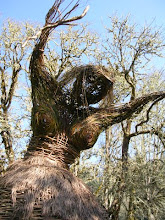
A thunderstorm swept through to the Northeast of us the other night. It wasn't close enough for the CRACK! but there was plenty of rumbling, grumbling, rolling thunder.
At the first big rumble Fiona the Princess cat dashed into the house from the cattery. Memories of July 4th fireworks, perhaps. She wasn't taking any chances.
On the second rattle and roll, I stepped out onto the deck. After several days of inversion, with temperatures at 100 or better and not a breath of wind, I was hoping for at least a fresh breeze - perhaps a little rain. So I sat and waited, watching the distant flashes and counting seconds, and worrying about fires in the Cascade mountains to the East.
On the third big rumble, the wild tom turkey who was apparently battened down in the woods next to the cul-de-sac down the hill let loose with a very irritated GABAB-
GABAB-GABABBLE. The rumbles and bumbles continued almost non-stop, and with each introductory boom old Tom voiced his warning: gabbletygabblety gabble.
Thunder: rolling basso profundo
Turkey: full-voiced tenor descant
After a few of those verses, the very large dog next door added his WURF WURF. The nearly-as-large dog down in the cul-de-sac joined in: RORF RORF.
thunder: basso profundo
turkey: tenor
dogs: baritone
THUMBLE Rummmmmble GABBLEGABBLE Wurf! Wurf! Rorf....
Needless to say, something more was needed, so the little yap dogs further down chimed in: alto and soprano. YIPPITY YAPPITY BARK BARK BARK.
You get the idea.
By now it was almost 11 pm and time for the Chorus: The voices of several dog owners, calling in their pooches.
The barking stopped, but the thunder and the turkey went on. And on.
A small breeze kicked up and I lifted my nose to appreciate it.
I have to wonder if turkeys always react this way to thunder, and if so, do turkey hunters every use this as a ploy to locate the birds at night?
I couldn't say....I only hunt with the camera.






























 alt="Click here to join FineArtsATC">
alt="Click here to join FineArtsATC">






